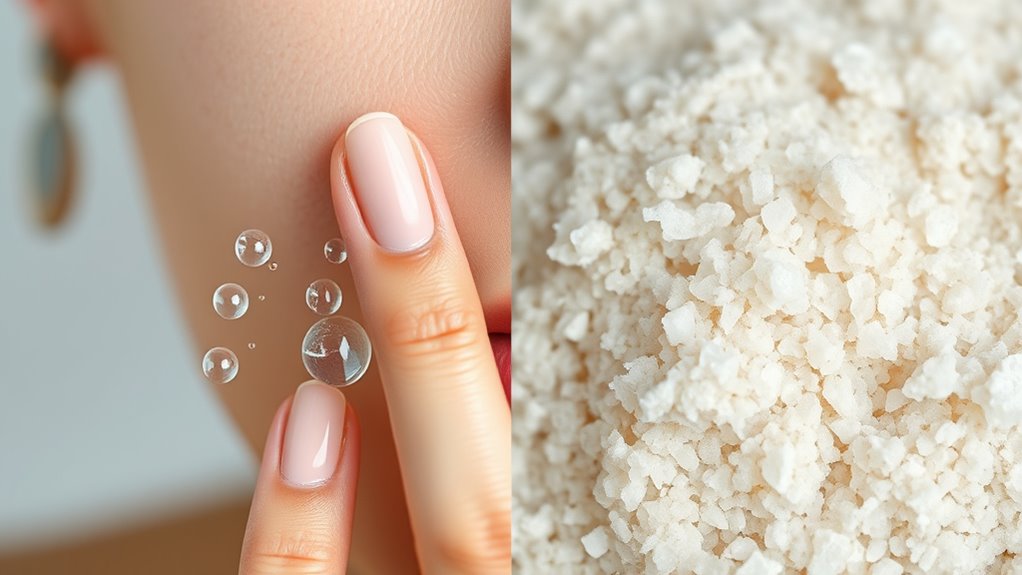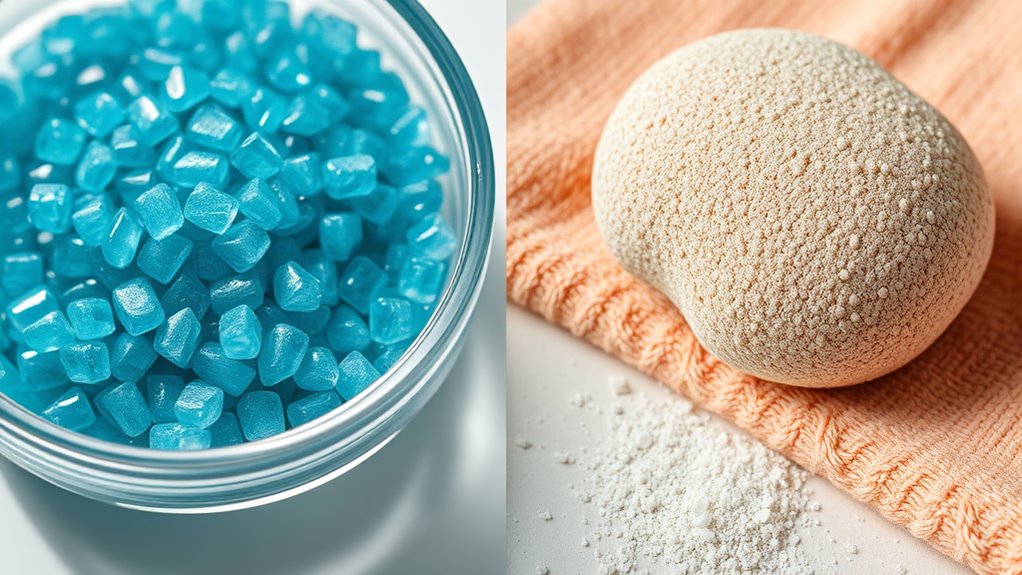Chemical exfoliation uses enzymes and acids to dissolve dead skin cells gently and evenly, making it suitable for sensitive skin and targeting issues like hyperpigmentation. Physical exfoliation involves manual scrubbing or abrasive tools to immediately smooth roughness and brighten your complexion but can cause irritation if too harsh. Choosing the right method depends on your skin type and concerns. To discover how to balance both for healthy skin, keep exploring the details ahead.
Key Takeaways
- Chemical exfoliation uses enzymes or acids to dissolve dead skin cells, providing uniform and often deeper results.
- Physical exfoliation involves manual removal with scrubs or brushes, offering immediate surface improvements.
- Chemical methods are generally gentler and better suited for sensitive skin, while physical methods can cause irritation if harsh.
- Chemical exfoliants target issues like hyperpigmentation and fine lines, whereas physical exfoliants mainly improve texture and brightness.
- Choosing the right method depends on skin type, concerns, and sensitivity, with proper technique preventing damage.
Understanding Chemical Exfoliation

Have you ever wondered how chemical exfoliation works to improve your skin? It involves using ingredients like enzyme exfoliation and acid peels to dissolve dead skin cells. Enzyme exfoliation uses natural enzymes, such as papain or bromelain, to gently break down proteins holding dead cells together, revealing smoother skin. Acid peels, on the other hand, contain acids like alpha hydroxy acids (AHAs) or beta hydroxy acids (BHAs) that chemically loosen the bonds between dead cells. Mindfulness techniques can help you approach your skincare routine with patience and awareness, enhancing the overall experience. These treatments penetrate deeper than physical scrubs, offering more uniform exfoliation. Chemical exfoliation is effective for reducing uneven texture, unclogging pores, and brightening your complexion. It’s important to choose the right type and strength for your skin type to avoid irritation and maximize benefits. Understanding skin sensitivities can help you select appropriate exfoliation methods, especially when considering vetted options like chemical exfoliation over physical scrubs. Recognizing the scientific principles behind these methods can also assist in making informed decisions about your skincare routine.
Understanding Physical Exfoliation

Did you know that physical exfoliation involves manually removing dead skin cells to reveal a fresher layer underneath? It’s one of the common exfoliation techniques that uses scrubs, brushes, or microbeads to slough off dead skin. This method immediately improves your skin texture by reducing roughness and unevenness. When you choose physical exfoliants, you physically scrub your skin, which stimulates circulation and promotes a brighter complexion. However, it’s essential to be gentle to avoid irritation or microtears. Physical exfoliation is suitable for those with resilient skin but may not be ideal for sensitive skin types. Regular use can smooth rough patches and enhance the overall appearance, giving your skin a healthier, more polished look. Additionally, understanding latest breakthroughs in machine learning tech can help skincare companies develop smarter, personalized exfoliation devices. Recognizing skin sensitivity levels can guide users in selecting the most appropriate method for their skin type, and staying informed about skincare innovation trends can further improve your skincare routine. Incorporating advanced diagnostic tools can also assist in customizing exfoliation strategies for optimal results.
Benefits and Drawbacks of Chemical Exfoliants

Chemical exfoliants offer a powerful way to renew your skin by dissolving dead cells without manual scrubbing. A chemical peel penetrates deeper, revealing fresh skin and improving texture. It can target issues like hyperpigmentation, acne scars, and fine lines, providing noticeable results with consistent use. Enzyme exfoliation is gentler, breaking down proteins in dead skin cells, making it suitable for sensitive skin types. However, chemical exfoliants can cause irritation, redness, or sensitivity if misused or if your skin reacts poorly. Over-exfoliating may weaken your skin’s barrier, leading to increased sensitivity. It’s essential to follow instructions and choose the right strength for your skin. While effective, chemical exfoliants require careful application and proper sun protection to avoid adverse effects. Incorporating adaptive learning technologies can help you understand your skin’s unique needs and select suitable exfoliants, especially when considering various formulation types and their compatibility with your skin. Additionally, understanding glycolic acid benefits can optimize your exfoliation routine, as it promotes cell turnover and improves skin texture.
Benefits and Drawbacks of Physical Exfoliants

Physical exfoliants mechanically slough off dead skin cells through scrubbing or polishing, offering immediate visible results. They’re effective for brightening your complexion and smoothing skin texture. However, if you use harsh or aggressive scrubbing, you risk irritating sensitive skin or causing microtears. Gentle scrubbing is key to minimizing skin sensitivity and avoiding damage. Incorporating crochet techniques can also help in creating gentle, controlled exfoliation methods using soft tools. Understanding skin sensitivity is essential to choosing the right exfoliation method and preventing adverse reactions. Additionally, selecting appropriate pressure during exfoliation can help avoid over-exfoliating delicate skin.
Choosing the Right Exfoliation Method for Your Skin

Choosing the right exfoliation method depends on your skin type, concerns, and lifestyle. If you have sensitive skin, opt for gentler options like chemical exfoliants with soothing ingredients, and limit exfoliation frequency to avoid irritation. For oily or acne-prone skin, physical scrubs can help remove excess oil and debris, but use them carefully to prevent damage. Dry or mature skin benefits from mild chemical exfoliants that promote cell turnover without over-stripping moisture. Pay attention to your skin’s reactions—if you notice redness or discomfort, reduce exfoliation frequency or switch methods. Regular but not excessive exfoliation supports healthy skin, so find a balance that keeps your skin smooth and clear without causing sensitivity or irritation. Additionally, understanding skin health and how different methods impact your skin can help you make more informed choices for your skincare routine. Incorporating proper skincare techniques can further enhance the benefits of exfoliation and protect your skin’s barrier. Being aware of pollutant exposure and its effects on skin can also guide you in choosing protective skincare practices.
Frequently Asked Questions
Can Exfoliation Cause Long-Term Skin Damage?
Exfoliation can cause long-term effects if you overdo it or choose harsh methods. Excessive exfoliation may weaken your skin barrier, leading to increased sensitivity and irritation over time. To avoid long-term damage, use gentle exfoliants and limit frequency. Proper exfoliation helps maintain healthy skin, but neglecting your skin’s needs can result in lasting harm. Always listen to your skin and stick to a suitable routine for safe, effective results.
How Often Should I Exfoliate for Sensitive Skin?
For sensitive skin, you should exfoliate using gentle techniques and follow frequency guidelines to avoid irritation. Generally, it’s best to exfoliate once a week or every two weeks, depending on your skin’s response. Pay attention to how your skin reacts and adjust accordingly. Always choose mild products designed for sensitive skin and avoid harsh scrubs, ensuring you’re not over-exfoliating, which can cause long-term damage.
Are Natural Ingredients Effective for Chemical Exfoliation?
Natural ingredients can be effective for chemical exfoliation if you choose the right DIY remedies. Herbal extracts like chamomile, aloe vera, and green tea contain gentle enzymes and antioxidants that help remove dead skin cells without harsh chemicals. You should be cautious, though, as not all natural remedies work for everyone, and some may cause irritation. Always patch-test and consult a dermatologist if unsure about using herbal extracts for exfoliation.
What Are Signs of Over-Exfoliation?
When you over-exfoliate, you might notice skin redness and peeling sensations that indicate irritation. Your skin could feel sensitive, tight, or appear inflamed, making it more prone to breakouts or dryness. If these signs persist, it’s a clear sign to cut back on exfoliation. Overdoing it strips away too much of your skin’s natural barrier, so always listen to your skin’s signals and avoid excessive scrubbing or harsh chemical use.
Can Exfoliation Improve Skin Conditions Like Acne or Hyperpigmentation?
Exfoliation can help improve skin conditions like acne and hyperpigmentation by unclogging pores and controlling excess oil. When you regularly exfoliate, you remove dead skin cells that clog pores, reducing breakouts and dark spots. This process also promotes cell turnover, leading to brighter, more even skin tone. Just be careful not to overdo it, as over-exfoliation can cause irritation and worsen your skin issues.
Conclusion
Now that you know the differences between chemical and physical exfoliation, which method suits your skin best? Considering your skin type and concerns can help you make the right choice for a healthier, brighter complexion. Remember, gentle exfoliation is key—overdoing it can cause irritation. So, aren’t you ready to choose the exfoliation method that will leave your skin glowing and refreshed? Take the time to find what works best for you!










